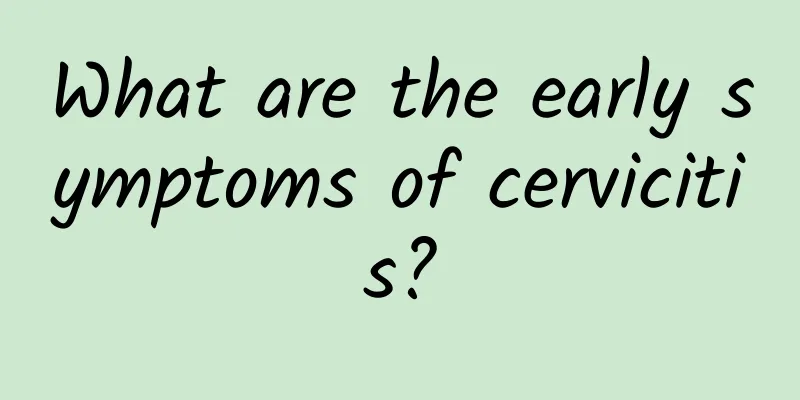What is the cause of cervical erosion and what are the hazards

|
Cervical erosion is a physiological phenomenon caused by the outward migration of cervical columnar epithelium. It is not a disease and usually does not require excessive concern. It is less harmful, but you need to be alert to its association with cervical inflammation or lesions. Regular cervical screening is recommended. 1. Common causes of cervical erosion Cervical erosion is not a pathological condition, but a phenomenon in which the cervical columnar epithelium migrates outward to the surface of the cervix due to changes in hormone levels. Young women are more prone to this condition due to their higher estrogen levels. Pregnancy and oral contraceptives may also cause the cervical columnar epithelium to migrate outward. Cervical inflammation, infection such as HPV infection, or mechanical stimulation such as frequent sexual intercourse and improper use of tampons may aggravate the symptoms of erosion and require attention. 2. The harm of cervical erosion Cervical erosion itself is less harmful, but it may mask cervical inflammation or lesions. If accompanied by symptoms such as increased vaginal discharge, odor, and bleeding after sexual intercourse, you should be alert to the possibility of cervicitis, cervical polyps, or cervical precancerous lesions. Long-term untreated cervical inflammation may increase the risk of HPV infection and develop into cervical cancer. Regular cervical cytology TCT and HPV testing are essential. 3. Treatment methods If cervical erosion is asymptomatic, no special treatment is usually required, but regular examinations are required. If accompanied by inflammation or infection, the following measures can be taken: Drug treatment: Antibiotics such as metronidazole are used for bacterial infections, and antiviral drugs such as interferon are used for HPV infections. Physical therapy: For patients with obvious symptoms, laser, freezing or electrocautery can be used to remove eroded tissue. Surgical treatment: For severe lesions or suspected precancerous lesions, cervical conization or LEEP knife surgery can be performed. Daily care: Keep the vulva clean, avoid using irritating lotions, choose underwear with good breathability, and avoid frequent sexual intercourse. 4. Prevention suggestions To prevent cervical erosion and related lesions, we need to start with lifestyle and health management. It is recommended to conduct regular cervical screening, especially HPV vaccination, which can effectively reduce the risk of cervical cancer. Maintaining good hygiene habits, avoiding unclean sexual behavior, enhancing immunity, eating a balanced diet, and exercising moderately, such as yoga and jogging, can help maintain cervical health. Although cervical erosion is a physiological phenomenon, its potential risks need to be paid attention to. Regular examination is the key to preventing cervical lesions. Through scientific management and a healthy lifestyle, the incidence of related diseases can be effectively reduced and women's health can be protected. |
<<: Is cervical erosion related to sex? Is it contagious?
>>: Is cervical hypertrophy a sign of intrauterine adhesion?
Recommend
What physical symptoms can ovarian cysts cause?
What are the signs of ovarian cysts? The initial ...
Is lymphatic drainage effective? Can lymphatic massage help you lose weight? Lymphedema therapists debunk 3 myths
Lymphedema has been classified as a new chronic d...
What should women do if they have irregular menstruation during menopause? Is it normal for women to have menstruation every 2-3 months during menopause?
What are the differences between the symptoms of ...
What are the common symptoms of multiple uterine fibroids?
Uterine fibroids are a disease suffered by many w...
How are uterine fibroids usually caused? How to prevent uterine fibroids
Uterine fibroids, also known as uterine leiomyoma...
What if the last few days of my period are brown?
What if the last few days of my period are brown?...
Did you know that uterine bleeding is a symptom of uterine fibroids?
Whether uterine fibroids have symptoms and their ...
What is endometriosis?
What is endometriosis? Endometriosis refers to th...
Uterine fibroids may usher in an era of non-invasive treatment
Uterine fibroids are the most common benign tumor...
What is Leucorrhea Cleanliness Level 3? White blood cells gradually increase
Clinically, vaginal cleanliness is usually divide...
What happens if you have moderate cervical erosion? What should you do?
What happens if you have moderate cervical erosio...
Which Chinese medicine can treat pelvic inflammatory disease
Which Chinese medicines can treat pelvic inflamma...
What are the correct ways to regulate irregular menstruation?
What are the correct ways to treat irregular mens...
Can patients with adenomyosis eat black fish?
Can people with adenomyosis eat black fish? If yo...
Diagnosis of early cervical precancerous lesions
Although technology is advanced nowadays, it is s...









